
A water-level view in Glacier National Park, Montana. Regenerative Agriculture, explains Roulac, describes "farming and grazing practices that reverse climate change by rebuilding soil organic matter and restoring degraded soil biodiversity--resulting in both carbon drawdown and an improved water cycle." (Photo: Cavan Images/via Getty Images)
Making America's Rivers Blue Again: Connecting the Dots Between Regenerative Agriculture and Healthy Waterways
Building a regenerative food system where bees buzz, dragonflies hover, and fish and frogs thrive will begin when we change hearts and minds. Fake meats and GMO soy are not the answer.
Two hundred years ago, before the Industrial Revolution, the rivers across North America ran clear and blue. Rivers from the mighty Mississippi to the Columbia flowed wild and clean into the sea.
In the 1800s and 1900s, the growth of manufacturing and agriculture across the continent brought prosperity to America, but at the great cost of unmitigated pollution. In 1969, Ohio's Cuyahoga River caught fire due to toxic runoff from nearby factories. This incident sparked the modern Earth Day movement and in 1972 helped pass the Clean Water Act, which established much-needed industrial regulations that considerably improved water quality in the United States. Unfortunately, lawmakers overlooked the negative impacts of agriculture on America's waterways.
"Regenerative agriculture is a renewal of hearts and minds that transforms farming and ranching. It is a conscientious agricultural system that mimics nature's patterns and prioritizes the health of the soil."
The food industry is complex and, like all established industries, focused on staying profitable. Today's agricultural practices result in rainstorms washing pesticides, fertilizers, feedlot manure, and bare soil into our waterways and oceans, turning rivers from clear reflections of blue skies to hues of greenish brown.
The good news: there are profitable and earth-friendly ways to grow nutrient-dense food, draw down carbon to address climate chaos, and return our rivers to their natural blue appearance. Soil regeneration is the solution.
"Regenerative Agriculture" describes farming and grazing practices that reverse climate change by rebuilding soil organic matter and restoring degraded soil biodiversity--resulting in both carbon drawdown and an improved water cycle. There are five recognized principles of regenerative agriculture: keep the soil covered, minimize soil disturbance, maximize crop diversity, maintain living roots in the ground year-round, and integrate livestock.

Discoloring Our Rivers
Satellite images show that many of America's rivers have changed color since 1984. It's as if someone used green and brown crayons to color over the blue waterways.
The massive change comes from modern farming practices, so reliant on tilling, pesticides, chemical fertilizers, and bare, fallow farmlands. Companies like Monsanto, Bayer, Dupont, and Syngenta (pesticides and genetics); Tyson, Smithfield, ADM, Bunge, and Cargill (processors); and General Mills, Danone, Nestle, Mars, Heinz, and Hormel (food brands)--hereinafter referred to as "Big Ag"--have built an agriculture system based on synthetic chemicals, massive federal subsidies, and consolidation (including red tape to prevent local food processing).
This not only hurts farmers' pocketbooks, but also the environment and human health. Big Ag has impacted policy in Washington, DC, and within land-grant ag universities. Today's specialization mindset has resulted in college graduates of agronomy knowing little about soil health, while medical school graduates know even less about nutrition. This is like throwing gasoline onto today's health crisis.
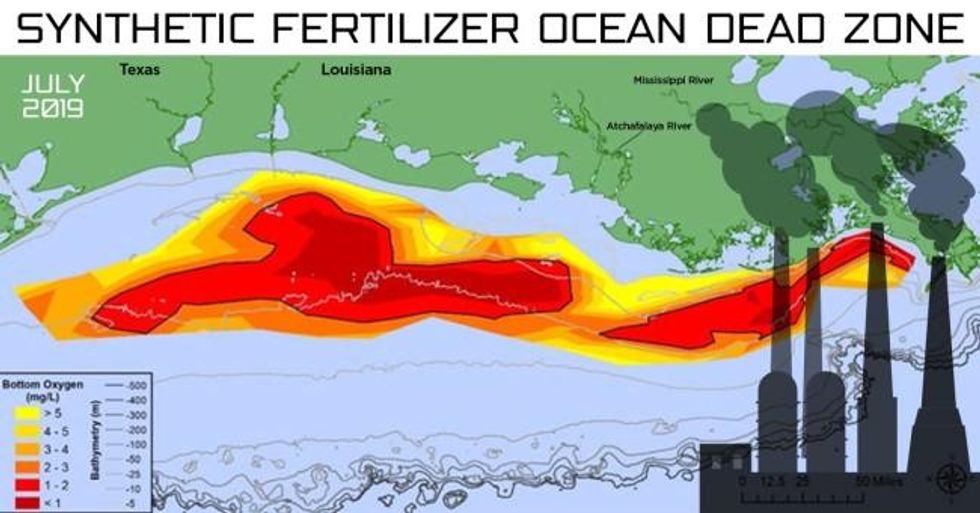
The synthetic fertilizers used by most U.S. farmers inevitably run off into waterways, color our rivers green with deadly algae blooms, and kill aquatic life (called eutrophication). For instance, the southern U.S. runoff zone, the Gulf of Mexico, is now a "dead zone" -- measuring 6,952 square miles in 2019.
Quoting my 2017 Ecowatch article Spaceship Earth, Your Main Oxygen Systems Are Collapsing:
"Industrial agriculture not only contaminates our oceans with pesticide and nitrogen-fertilizer runoff . . . it is stripping our soils of carbon, which ends up in the oceans and creates acidification. At the current trajectory, in just a few decades there won't be much left alive in our oceans as the phytoplankton dies--all because of how we grow our food."
It's important to understand that fertilizer is predominantly made from fracked natural gas, releasing nitrous oxide (N2O)--a greenhouse gas 300 times more potent than carbon dioxide but virtually ignored in climate change discussions. In a recent study published in the journal Nature, an international team of scientists discovered that N2O emissions are increasing at a faster rate than any other type of greenhouse gas emission, mainly due to a rise in nitrogen fertilizer application for food production.
Concentrated Animal Feeding Operations (CAFOs) are also a big contributor to U.S. river pollution. There are somewhat more cows today in the U.S. versus bison (which are much larger) two centuries ago. The real issue is nitrous oxide belching from fertilizer plants not from cows munching grass. Monsanto, the fertilizer industry, and Impossible Foods is betting they can pull a fast one on Americans.
America's consumption of CAFO chicken is growing, with more than nine billion broilers produced for KFC, Chick-fil-A, and retailers such as Costco each year. Rural America is a sacrifice zone, dealing with impacts to both air and water. Over 20% of rural wells in ag regions are contaminated from synthetic fertilizers.
Let us remember "Mni Wiconi" (a Native American saying meaning Water is Life). Farmers who practice regenerative agriculture can reduce their chemical inputs, saving millions of dollars while building healthy, spongy soil with an increased water-holding capacity. Such practices will keep our streams, rivers, lakes, and gulfs flowing with clear, fresh blue water.
Got GMOs?
It's not just our waterways that are being harmed. A shocking new study published in the Proceedings of the National Academies of Sciences notes that insect populations are dropping 1-2% per year and ". . . are absolutely the fabric by which Mother Nature and the tree of life are built." Scientists believe pesticides are a leading cause of this collapse. Some critics of regenerative agriculture focus on carbon and miss other linkages.
As prominent entomologist Dr. Jonathan Lundgren emphasized, "This isn't a bee problem. The bees are the canary in the coal mine. This is the worst mass extinction event that the planet has ever experienced. Agriculture has become much too simplified." The use of genetically modified organisms (GMOs) is promoted as if they were the only way to produce food in the 21st century. Ken Roseboro, editor of The Organic & of the Non-GMO Report recently said, "Several regenerative farmers have told me they just don't need the GMO traits, and their yields are better with non-GMO seeds."
The problem of pesticides is intimately linked to that of GMOs. The majority of GMO seeds sold today are genetically engineered to work with toxic herbicides such as glyphosate.
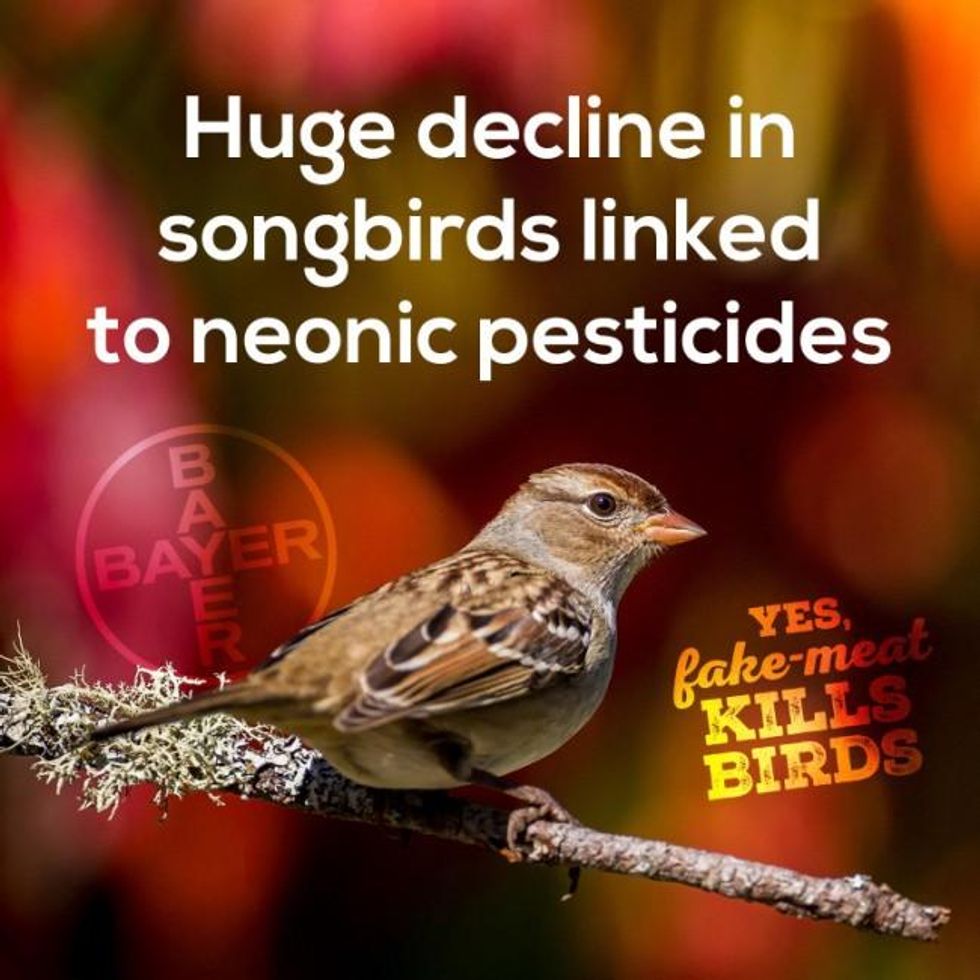
This extinction machine starts right in the seed-processing plant. Virtually all GMO seeds (in addition to other seeds and even nursery plants) are treated with neonicotinoids, neurotoxins so persistent that they destroy life on the scale of entire ecosystems--bees, insects, birds, mammals. France has mostly banned their use.
Pesticide and fertilizer factories stink and produce poisons. They are located mostly in disadvantaged communities whose residents already suffer from myriad health issues, and this national issue reeks of environmental discrimination.
The Myths of Fake Meat
"The mad rush for fake food and fake meat," writes Dr. Vandana Shiva, "is a recipe for accelerating the destruction of the planet and our health."
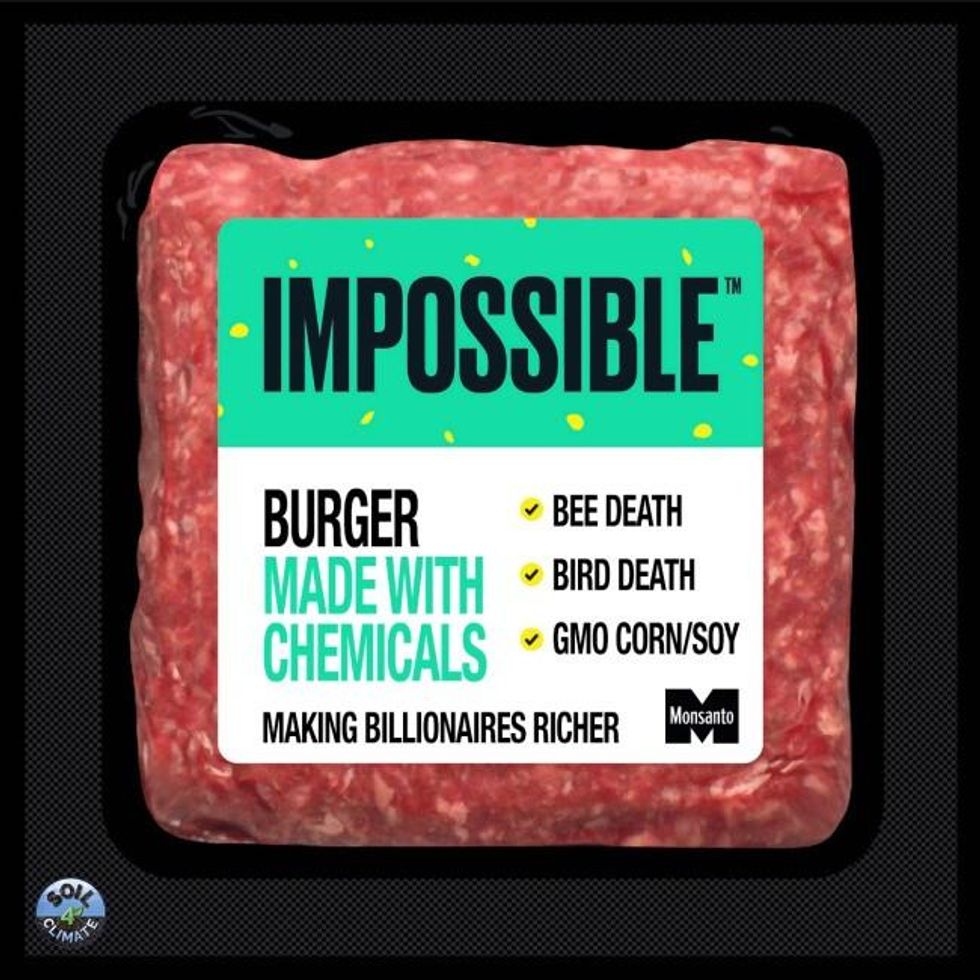
The modus operandi of the CAFO giants (Tyson, Hormel, Smithfield, et al) is to continue producing ecologically devastating factory-farmed feedlot beef, chicken, and pork while simultaneously introducing patented and highly processed fake-meat foods. Plant-based meat alternatives are a superb way of distracting health-and-animal-rights-oriented consumers from Big Ag's overreliance on tillage, monocrops, GMOs, and toxic pesticides. Many Americans now shy away from GMO foods, switching to certified Non-GMO, pasture-finished, and organic foods.
"Most people don't understand the earth's water and carbon cycles, and this results in destruction of our natural resources."
What is a dominant industry to do? Fear not, Big Ag has a plan: combine its GMO and other crops into novel products that approximate meat, rebrand them as "plant-based," et voila!
Properly grown plant-based foods are fine, but the key is "properly grown." Little of the emerging plant-based foods are grown using health principles, which is how we end up with paradoxes like vegans and Monsanto becoming bedfellows. Beyond Meat using non-GMO pea protein is a much better choice than the GMO soy, corn, and heme Impossible Burger; yet both are highly processed.
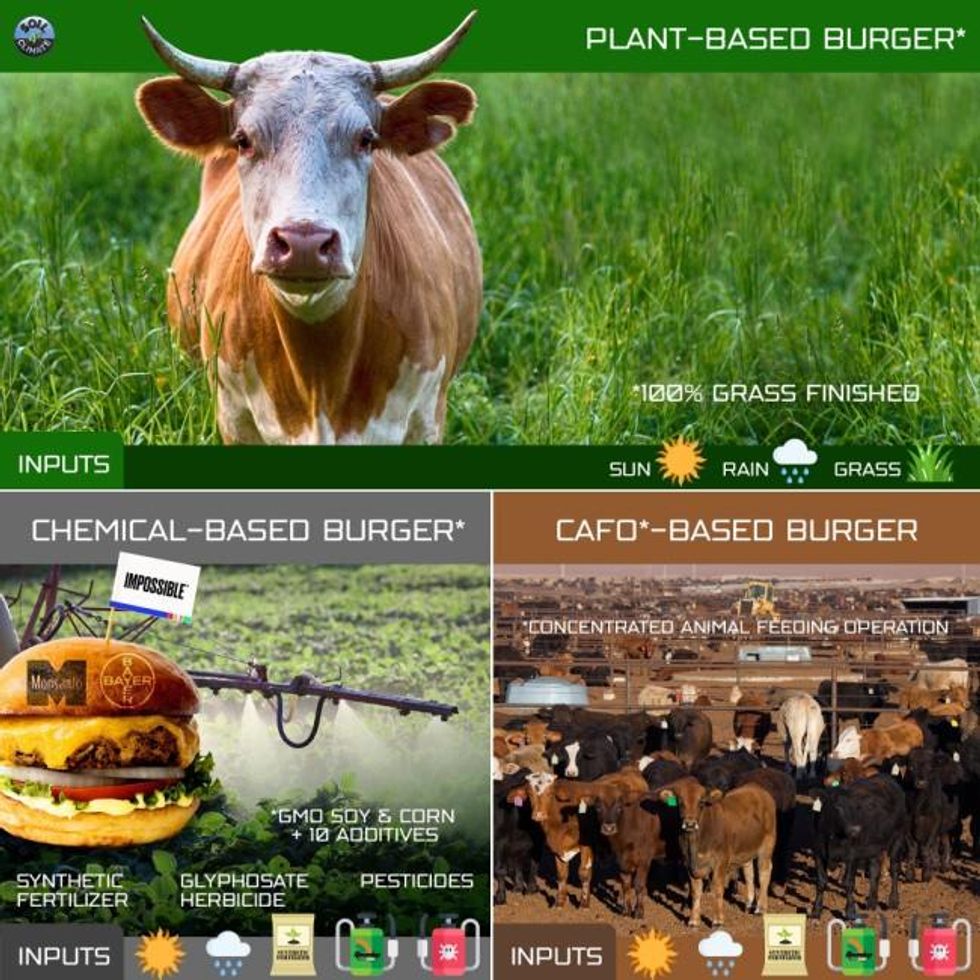
Missing the Mark
Big Ag has rebranded "plant-based" and partnered with a high-powered "greenwash orchestra" to sing the praises of bird-killing meat alternatives. How vegan is that? A powerful alliance of Wall Street and Silicon Valley investors, Big Ag executives, and the billionaire-backed plant-based food industry, with their well-paid allies from Oxford University and The Guardian, form the choir. The soloists? A sprinkling of misinformed environmentalists and animal rights activists. Most of these "experts" lack scientific curiosity, undervalue the promise of regenerative agriculture, and thus are missing the mark of regen ag.
It's a lot easier for some to dismiss all meat consumption as unethical. The emerging holistic regenerative grazing practice improves biodiversity and soil carbon drawdown. It is profoundly different from destructive CAFOs and conventional grazing that promulgates soil erosion.
The best propaganda is carried out by those who don't even realize they're engaged in it. These people share some traits of cult zealots, spinning oft-repeated untruths such as "meat is bad, and plants (referring to annual grains) are good." Their main rationale: soil-killing farming practices are acceptable because plants are not meat. Manipulative marketing campaigns suggest that 100% pastured beef is "worse" than CAFO beef. Many rely on outdated, old-school ag research.
As Aldous Huxley eloquently wrote,"Facts do not cease to exist because they are ignored." In this case, the fact ignored is that hoofed animals are essential to restoring the earth's vast grasslands through holistic grazing, with a huge upside for carbon sequestration achieved where farm crops cannot grow.
In holistic regenerative systems, animals graze the grass and do not return until the grass is knee-high. While it seems counterintuitive, over time more animals--not less-- will be needed as the grassland regenerates. On February 17, 2021 The New York Times article featured Texas rancher Adam Isaacs and his goal of turning his 5,000 acres into something closer to the lush mixed-grass prairie that once thrived in this part of the Southern Great Plains and served as grazing lands for millions of bison. This emerging science of holistic grazing is conveniently ignored, much as AT&T in the '90s dismissed the nascent Internet revolution.
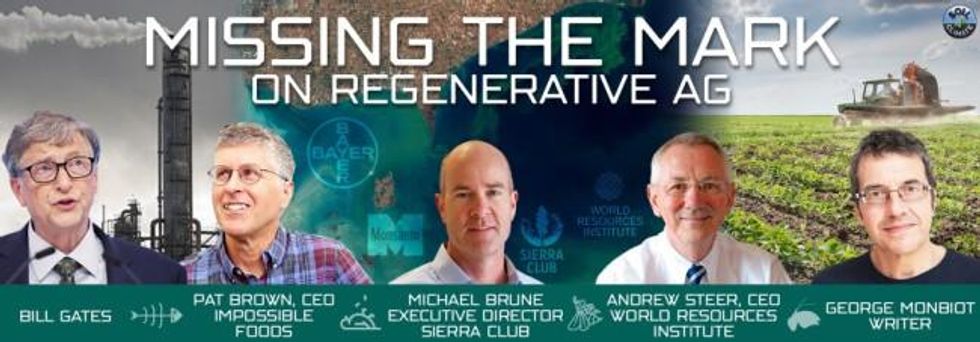
Leaders who are "missing the mark" and thus helping to pollute America's rivers include:
1. Bill Gates, a major investor in fake-meat companies (such as $50M investment in Impossible Foods), is also a major funder of chemical GMO agriculture. While his foundation has done other good work, (along with Gates recent focus on greening the cement and steel sectors) his investments in Monsanto represents a double standard.
Gates is now the top private farmland owner in America, and his alliance with Bayer/Monsanto jeopardizes vast amounts of American farmland. In 2006, the Bill & Melinda Gates and Rockefeller Foundations launched the nearly $1B Alliance for a Green Revolution in Africa (AGRA), promising to double crop productivity and boost incomes for 30 million small farmers by 2020. This resulted in significant failure that ignored regional food solutions while pushing high-tech fertilizers, pesticides, and hybrid seeds.
Ironically, Fonio, Africa's most valuable native superfood grain, which does not require fertilizers or pesticides, was not promoted. Perhaps Bill Gates will change operating systems to embrace regeneration and resiliency.
2. Impossible Foods CEO Pat Brown, who has declared that he wants to end all animal agriculture by 2035. Regenerative ag advocate and Soil4Climate co-founder Seth Itzkan states, "Impossible Foods should really be called Impossible Patents. It is not food; it's software, intellectual property -- 14 patents in each bite of Impossible Burger. It's iFood, the next killer app."
Supporting Cast:
3. The Sierra Club, which has attacked regenerative ag while promoting the Impossible Burger (made with Bayer/Monsanto's bee-killing GMO soy and corn) via tweets and videos. It is encouraging to see several Sierra Club ag state chapters prioritize soil health. For example, the Iowa chapter has an excellent farm policy that acknowledges the role of animals in soil health. However, to date the national headquarters has chosen to ignore the Midwest chapters. The Club has received over $140M from Michael Bloomberg.
4. World Resource Institute (WRI) has published reports dismissing the potential of regenerative agriculture while undervaluing the role of holistic grazing and healthy soil biology. Six leading researchers from the U.S., France, and Scotland recently disputed a WRI report, stating, "The science is clear that regenerative agricultural practices have the biophysical capability to contribute significantly to both soil health and climate change mitigation!"
A web data search of WRI's food reports yields no results for Monsanto or Bayer. How can this NGO address global environmental and food issues with no mention of the world's largest pesticide and GMO seed companies? And, in 2008, a WRI blog post said of Monsanto's cancer-linked glyphosate: "The weed killer is generally considered safe for workers."
Further, the WRI July 2019 Sustainable Food Report/Course 5, "Reduce Greenhouse Gas Emissions from Agriculture Production," listed four key approaches yet overlooked regen ag as a key driver to reduce nitrogen demand. From America to Africa, regen farmers and ranchers (far from WRI's DC and London offices ) are proving that food can be grown without copious amounts of nitrogen fertilizers .
WRI influences UN food policies and attracts big money; Jeff Bezos recently donated $100M. Like the Sierra Club, WRI does good work in forestry, yet its food-policy research leaves much to be desired.
5. British writer and animal rights activist George Monbiot pushes a plant-based view while dismissing non-vegan regenerative agriculture. Like many urban environmentalists, Monbiot mistakenly views grazing animals as the enemy to be removed.
In 2015 Ecowatch published my letter "Why Are Climate Groups Only Focused on 50% of the Solution?" describing how soil health regeneration could address climate chaos. Paul Hawken's Project Drawdown shows that many of the leading climate solutions are nature-based (soils, forestry, agroforestry, holistic grazing, etc.) While many national environmental groups have kept their heads buried in the sand, the Natural Resources Defense Council (NRDC) is actively promoting the importance of soil health. And I applaud the National Audubon Society's 2019 article, "Grazing Like It's 1799: How Ranchers Can Bring Back Grassland Birds." A new ranching generation is taking cues from historical bison herds to help prairies and wildlife.
"Each 1% increase in soil organic matter helps hold another 20,000 gallons of water per acre, making the land more resistant to droughts and floods."
The challenge: Most people don't understand the earth's water and carbon cycles, and this results in destruction of our natural resources. Regenerative ag opponents hold misguided positions, including "Eating meat is murder, so vegan industrial farming is good"; "Tweak the incumbent system and eat less meat", and "Regenerative agriculture isn't a viable solution."
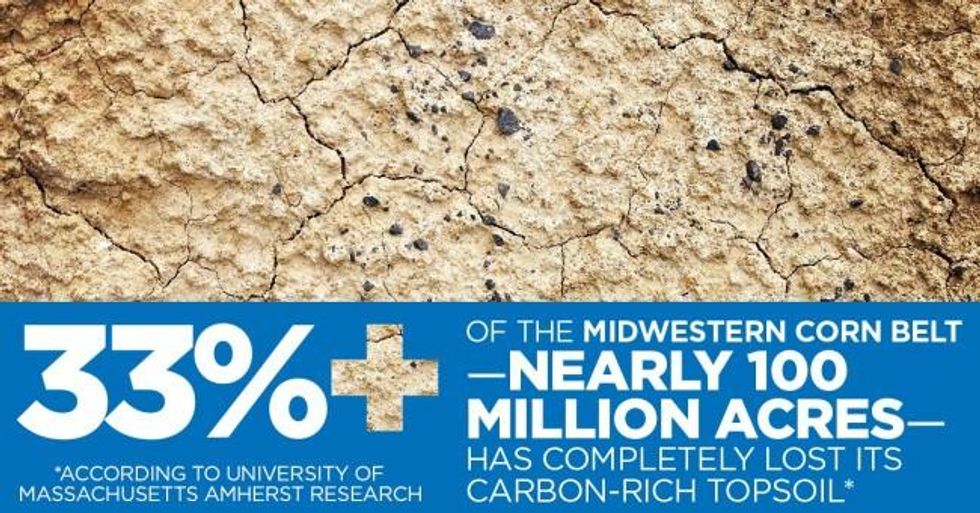
Soil Regeneration Is the Answer
Regenerative agriculture is a renewal of hearts and minds that transforms farming and ranching. It is a conscientious agricultural system that mimics nature's patterns and prioritizes the health of the soil. Regenerative farmers use cover crops (keeping soil covered year-round), agroforestry, and holistic animal grazing. Large-scale farmers like Rick Clark of Indiana, who successfully manages a 7,000 acre, no-till organic regenerative farming operation, are demonstrating how soil health is transforming agriculture.
Here are five useful measurement tools for quantifying regenerative agriculture.
"Farmers," Dr. Kris Nichols observes, "harvest sunlight via living root systems and expand soil microbial life." And no wonder: The microbes in a teaspoon of healthy soil rivals the people who live on earth. And this directly impacts resilience.
Each 1% increase in soil organic matter helps hold another 20,000 gallons of water per acre, making the land more resistant to droughts and floods. Vast amounts of carbon are thus sequestered as soil organic matter increases. And this helps restore the water cycle, which many believe may be even more important than the carbon cycle to moderate climate chaos. Regeneration offers society a resilient natural wealth account, one we can draw upon as climatic turmoil heads our way. The fastest way to grow our natural wealth is by restoring degraded lands.
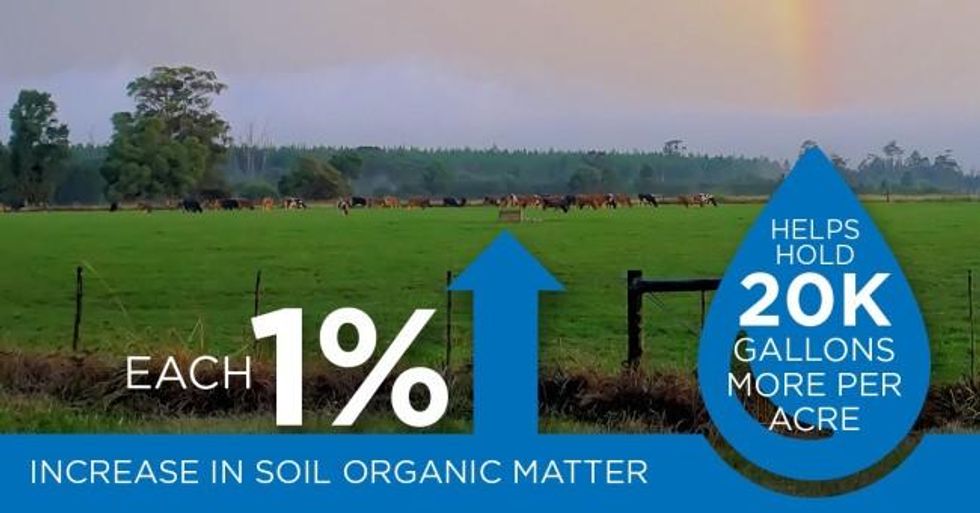
The Netflix film blockbuster Kiss the Ground (of which I'm an Executive Producer) shows us what the future is made of: a dynamic and growing movement of farmers, ranchers, investors, and food advocates creating a new dawn for agriculture. Almost miraculously, red state Republicans and deep-blue coastal environmentalists are uniting around the rallying cry of healthy soil, healthy plants, healthy rivers, healthy animals, healthy people, and healthy climate. Many conventional large-scale farmers, focusing on soil health, have used regenerative practices to reduce their synthetic input consumption by 50-75% after just four or five years. Even Big Ag is beginning to get the message, as challengers inside Big Ag companies are starting to push regeneration to help farmers become more profitable and protect their soils. Perhaps most encouraging of all, regeneration is increasingly driven by women, bringing a more holistic mindset to the movement.
Even food giants such as General Mills are starting to shift their supply chains by contracting with regenerative ag leader Understanding Ag (Ray Archuleta/Gabe Brown/Dr. Allen Williams/Shane New). Danone has committed to converting 100,000 acres to regenerative practices by 2022. Cargill recently partnered with Rodale in an unlikely alliance to increase organic farmland, with a goal of transitioning 50,000 acres of corn and soy to organic. Oregon fast-food chain Burgerville proudly features its No. 6 Burger made with 100% grass-fed, grass-finished beef.
In Guatemala, Contour Lines Corp. is replacing "slash-and-burn" ag with organic food forests to empower dozens of indigenous communities. Anthony Myint has founded Zero Food Print, a program for restaurants to add a few cents' cost to each meal, using funds to create a table-to-farm movement that helps farmers implement regenerative practices. Sixth-generation Iowa farmer Mitchell Hora is creating digital tools for farmers to use to build healthier soil. American Sustainable Business Council's Regenerative Agriculture Working Group has been highly engaged, bringing 70 businesses, investors, and organizations to drive innovative and inclusive state and federal regenerative agriculture and food justice policy solutions.
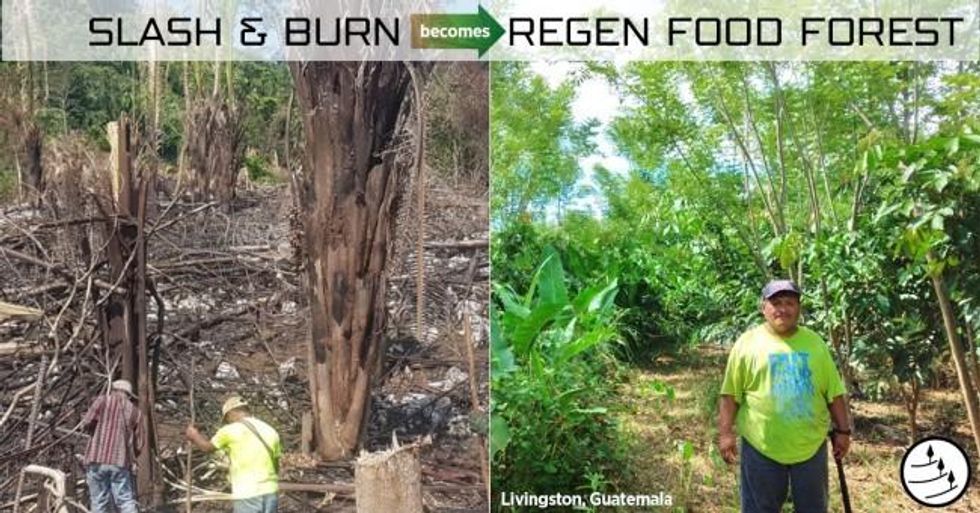
For eons, indigenous peoples have grazed animals for food, fiber, and sustenance. They don't see themselves as separate from nature. Urban elites who dismiss the need for animals betray their lack of ecological literacy. Worse, their mindset can be seen as colonialist, for many pastoralist communities around the world still depend on livestock for their livelihoods.
Sadly, Western history and policies have discriminated against people of color. Yet a growing movement exists to change federal policies to allow loans and land access to Black and Native American farmers and ranchers. One such project is the Rosebud Economic Development Corporation (REDCO), including the Rosebud Sioux Tribe's plan to build a 1,500-head bison herd on 28,000 acres of tribal land by 2025, with support from the U.S. Department of the Interior and World Wildlife Fund.
Personal Health Begins in the Soil
Contemporary soil quality is so poor that today's food contains a mere fraction of the minerals and vitamins it held eighty years ago.
Today's degenerate food system (factory meat or plant-based) is fueled by Omega-6-laden corn, soy, and canola oil, which are leading contributors to heart disease and inflammation. A CAFO burger has up to four times more Omega-6 and five times less Vitamin E than a 100% pasture-raised burger. Persistent pesticide use leads to human and animal gut-health issues. A new study published in January 2021 reveals evidence that glyphosate and Roundup disturb gut microbiome and blood biochemistry at doses that regulators claim to be safe. So, while factory-farmed meat is abhorrent, many of the plant-based alternatives found in the supermarket can damage our earth and our bodies in much the same way that factory meats do. Regenerative food is more nutrient-dense, and it nurtures our immune system and gut biome.
"Contemporary soil quality is so poor that today's food contains a mere fraction of the minerals and vitamins it held eighty years ago."
As the NRDC aptly states, ". . . we started learning about soil health because the topic intersects very closely with our water conservation advocacy. Scientists, farmers and ranchers, public health experts, and ecologists taught us about soil's role in improving the water cycle, sequestering carbon, increasing biodiversity, reducing toxic pesticide and synthetic input use, improving rural livelihoods, providing climate resilience, and growing healthier foods. Regenerative agriculture was the phrase that kept coming up."
Regeneration Six-Punch List
Here are six things you can do to help regenerate our lovely earth:
1. Purchase more regionally grown, non-GMO, organic and regenerative food that is raised in harmony with soil health principles, and where possible, know your farmer.
2. Look for pasture-finished meat or organically grown or ethically raised meat labels. Seek out regional, small-farm butchers and ranchers. Avoid industry-owned grocery brands such as Applegate (owned by Hormel) or Tyson.
3. Compost food scraps and leaves at your dwelling, land, organization, or municipal facility.
4. Contact your members of Congress to encourage President Joe Biden and USDA Secretary Tom Vilsack to support soil health and regeneration.
5. Invest in or volunteer your support for local food producers working to improve their soil and regeneration practices.
6. Watch soil-health documentary Kiss the Ground on Netflix and share it with your network.
Let's build a regenerative food system where bees buzz, dragonflies hover, and fish and frogs thrive. It's going to take a change of hearts and minds; only then will America's rivers run blue again. Let's regenerate.
An Urgent Message From Our Co-Founder
Dear Common Dreams reader, The U.S. is on a fast track to authoritarianism like nothing I've ever seen. Meanwhile, corporate news outlets are utterly capitulating to Trump, twisting their coverage to avoid drawing his ire while lining up to stuff cash in his pockets. That's why I believe that Common Dreams is doing the best and most consequential reporting that we've ever done. Our small but mighty team is a progressive reporting powerhouse, covering the news every day that the corporate media never will. Our mission has always been simple: To inform. To inspire. And to ignite change for the common good. Now here's the key piece that I want all our readers to understand: None of this would be possible without your financial support. That's not just some fundraising cliche. It's the absolute and literal truth. We don't accept corporate advertising and never will. We don't have a paywall because we don't think people should be blocked from critical news based on their ability to pay. Everything we do is funded by the donations of readers like you. Will you donate now to help power the nonprofit, independent reporting of Common Dreams? Thank you for being a vital member of our community. Together, we can keep independent journalism alive when it’s needed most. - Craig Brown, Co-founder |
Two hundred years ago, before the Industrial Revolution, the rivers across North America ran clear and blue. Rivers from the mighty Mississippi to the Columbia flowed wild and clean into the sea.
In the 1800s and 1900s, the growth of manufacturing and agriculture across the continent brought prosperity to America, but at the great cost of unmitigated pollution. In 1969, Ohio's Cuyahoga River caught fire due to toxic runoff from nearby factories. This incident sparked the modern Earth Day movement and in 1972 helped pass the Clean Water Act, which established much-needed industrial regulations that considerably improved water quality in the United States. Unfortunately, lawmakers overlooked the negative impacts of agriculture on America's waterways.
"Regenerative agriculture is a renewal of hearts and minds that transforms farming and ranching. It is a conscientious agricultural system that mimics nature's patterns and prioritizes the health of the soil."
The food industry is complex and, like all established industries, focused on staying profitable. Today's agricultural practices result in rainstorms washing pesticides, fertilizers, feedlot manure, and bare soil into our waterways and oceans, turning rivers from clear reflections of blue skies to hues of greenish brown.
The good news: there are profitable and earth-friendly ways to grow nutrient-dense food, draw down carbon to address climate chaos, and return our rivers to their natural blue appearance. Soil regeneration is the solution.
"Regenerative Agriculture" describes farming and grazing practices that reverse climate change by rebuilding soil organic matter and restoring degraded soil biodiversity--resulting in both carbon drawdown and an improved water cycle. There are five recognized principles of regenerative agriculture: keep the soil covered, minimize soil disturbance, maximize crop diversity, maintain living roots in the ground year-round, and integrate livestock.

Discoloring Our Rivers
Satellite images show that many of America's rivers have changed color since 1984. It's as if someone used green and brown crayons to color over the blue waterways.
The massive change comes from modern farming practices, so reliant on tilling, pesticides, chemical fertilizers, and bare, fallow farmlands. Companies like Monsanto, Bayer, Dupont, and Syngenta (pesticides and genetics); Tyson, Smithfield, ADM, Bunge, and Cargill (processors); and General Mills, Danone, Nestle, Mars, Heinz, and Hormel (food brands)--hereinafter referred to as "Big Ag"--have built an agriculture system based on synthetic chemicals, massive federal subsidies, and consolidation (including red tape to prevent local food processing).
This not only hurts farmers' pocketbooks, but also the environment and human health. Big Ag has impacted policy in Washington, DC, and within land-grant ag universities. Today's specialization mindset has resulted in college graduates of agronomy knowing little about soil health, while medical school graduates know even less about nutrition. This is like throwing gasoline onto today's health crisis.

The synthetic fertilizers used by most U.S. farmers inevitably run off into waterways, color our rivers green with deadly algae blooms, and kill aquatic life (called eutrophication). For instance, the southern U.S. runoff zone, the Gulf of Mexico, is now a "dead zone" -- measuring 6,952 square miles in 2019.
Quoting my 2017 Ecowatch article Spaceship Earth, Your Main Oxygen Systems Are Collapsing:
"Industrial agriculture not only contaminates our oceans with pesticide and nitrogen-fertilizer runoff . . . it is stripping our soils of carbon, which ends up in the oceans and creates acidification. At the current trajectory, in just a few decades there won't be much left alive in our oceans as the phytoplankton dies--all because of how we grow our food."
It's important to understand that fertilizer is predominantly made from fracked natural gas, releasing nitrous oxide (N2O)--a greenhouse gas 300 times more potent than carbon dioxide but virtually ignored in climate change discussions. In a recent study published in the journal Nature, an international team of scientists discovered that N2O emissions are increasing at a faster rate than any other type of greenhouse gas emission, mainly due to a rise in nitrogen fertilizer application for food production.
Concentrated Animal Feeding Operations (CAFOs) are also a big contributor to U.S. river pollution. There are somewhat more cows today in the U.S. versus bison (which are much larger) two centuries ago. The real issue is nitrous oxide belching from fertilizer plants not from cows munching grass. Monsanto, the fertilizer industry, and Impossible Foods is betting they can pull a fast one on Americans.
America's consumption of CAFO chicken is growing, with more than nine billion broilers produced for KFC, Chick-fil-A, and retailers such as Costco each year. Rural America is a sacrifice zone, dealing with impacts to both air and water. Over 20% of rural wells in ag regions are contaminated from synthetic fertilizers.
Let us remember "Mni Wiconi" (a Native American saying meaning Water is Life). Farmers who practice regenerative agriculture can reduce their chemical inputs, saving millions of dollars while building healthy, spongy soil with an increased water-holding capacity. Such practices will keep our streams, rivers, lakes, and gulfs flowing with clear, fresh blue water.
Got GMOs?
It's not just our waterways that are being harmed. A shocking new study published in the Proceedings of the National Academies of Sciences notes that insect populations are dropping 1-2% per year and ". . . are absolutely the fabric by which Mother Nature and the tree of life are built." Scientists believe pesticides are a leading cause of this collapse. Some critics of regenerative agriculture focus on carbon and miss other linkages.
As prominent entomologist Dr. Jonathan Lundgren emphasized, "This isn't a bee problem. The bees are the canary in the coal mine. This is the worst mass extinction event that the planet has ever experienced. Agriculture has become much too simplified." The use of genetically modified organisms (GMOs) is promoted as if they were the only way to produce food in the 21st century. Ken Roseboro, editor of The Organic & of the Non-GMO Report recently said, "Several regenerative farmers have told me they just don't need the GMO traits, and their yields are better with non-GMO seeds."
The problem of pesticides is intimately linked to that of GMOs. The majority of GMO seeds sold today are genetically engineered to work with toxic herbicides such as glyphosate.

This extinction machine starts right in the seed-processing plant. Virtually all GMO seeds (in addition to other seeds and even nursery plants) are treated with neonicotinoids, neurotoxins so persistent that they destroy life on the scale of entire ecosystems--bees, insects, birds, mammals. France has mostly banned their use.
Pesticide and fertilizer factories stink and produce poisons. They are located mostly in disadvantaged communities whose residents already suffer from myriad health issues, and this national issue reeks of environmental discrimination.
The Myths of Fake Meat
"The mad rush for fake food and fake meat," writes Dr. Vandana Shiva, "is a recipe for accelerating the destruction of the planet and our health."

The modus operandi of the CAFO giants (Tyson, Hormel, Smithfield, et al) is to continue producing ecologically devastating factory-farmed feedlot beef, chicken, and pork while simultaneously introducing patented and highly processed fake-meat foods. Plant-based meat alternatives are a superb way of distracting health-and-animal-rights-oriented consumers from Big Ag's overreliance on tillage, monocrops, GMOs, and toxic pesticides. Many Americans now shy away from GMO foods, switching to certified Non-GMO, pasture-finished, and organic foods.
"Most people don't understand the earth's water and carbon cycles, and this results in destruction of our natural resources."
What is a dominant industry to do? Fear not, Big Ag has a plan: combine its GMO and other crops into novel products that approximate meat, rebrand them as "plant-based," et voila!
Properly grown plant-based foods are fine, but the key is "properly grown." Little of the emerging plant-based foods are grown using health principles, which is how we end up with paradoxes like vegans and Monsanto becoming bedfellows. Beyond Meat using non-GMO pea protein is a much better choice than the GMO soy, corn, and heme Impossible Burger; yet both are highly processed.

Missing the Mark
Big Ag has rebranded "plant-based" and partnered with a high-powered "greenwash orchestra" to sing the praises of bird-killing meat alternatives. How vegan is that? A powerful alliance of Wall Street and Silicon Valley investors, Big Ag executives, and the billionaire-backed plant-based food industry, with their well-paid allies from Oxford University and The Guardian, form the choir. The soloists? A sprinkling of misinformed environmentalists and animal rights activists. Most of these "experts" lack scientific curiosity, undervalue the promise of regenerative agriculture, and thus are missing the mark of regen ag.
It's a lot easier for some to dismiss all meat consumption as unethical. The emerging holistic regenerative grazing practice improves biodiversity and soil carbon drawdown. It is profoundly different from destructive CAFOs and conventional grazing that promulgates soil erosion.
The best propaganda is carried out by those who don't even realize they're engaged in it. These people share some traits of cult zealots, spinning oft-repeated untruths such as "meat is bad, and plants (referring to annual grains) are good." Their main rationale: soil-killing farming practices are acceptable because plants are not meat. Manipulative marketing campaigns suggest that 100% pastured beef is "worse" than CAFO beef. Many rely on outdated, old-school ag research.
As Aldous Huxley eloquently wrote,"Facts do not cease to exist because they are ignored." In this case, the fact ignored is that hoofed animals are essential to restoring the earth's vast grasslands through holistic grazing, with a huge upside for carbon sequestration achieved where farm crops cannot grow.
In holistic regenerative systems, animals graze the grass and do not return until the grass is knee-high. While it seems counterintuitive, over time more animals--not less-- will be needed as the grassland regenerates. On February 17, 2021 The New York Times article featured Texas rancher Adam Isaacs and his goal of turning his 5,000 acres into something closer to the lush mixed-grass prairie that once thrived in this part of the Southern Great Plains and served as grazing lands for millions of bison. This emerging science of holistic grazing is conveniently ignored, much as AT&T in the '90s dismissed the nascent Internet revolution.

Leaders who are "missing the mark" and thus helping to pollute America's rivers include:
1. Bill Gates, a major investor in fake-meat companies (such as $50M investment in Impossible Foods), is also a major funder of chemical GMO agriculture. While his foundation has done other good work, (along with Gates recent focus on greening the cement and steel sectors) his investments in Monsanto represents a double standard.
Gates is now the top private farmland owner in America, and his alliance with Bayer/Monsanto jeopardizes vast amounts of American farmland. In 2006, the Bill & Melinda Gates and Rockefeller Foundations launched the nearly $1B Alliance for a Green Revolution in Africa (AGRA), promising to double crop productivity and boost incomes for 30 million small farmers by 2020. This resulted in significant failure that ignored regional food solutions while pushing high-tech fertilizers, pesticides, and hybrid seeds.
Ironically, Fonio, Africa's most valuable native superfood grain, which does not require fertilizers or pesticides, was not promoted. Perhaps Bill Gates will change operating systems to embrace regeneration and resiliency.
2. Impossible Foods CEO Pat Brown, who has declared that he wants to end all animal agriculture by 2035. Regenerative ag advocate and Soil4Climate co-founder Seth Itzkan states, "Impossible Foods should really be called Impossible Patents. It is not food; it's software, intellectual property -- 14 patents in each bite of Impossible Burger. It's iFood, the next killer app."
Supporting Cast:
3. The Sierra Club, which has attacked regenerative ag while promoting the Impossible Burger (made with Bayer/Monsanto's bee-killing GMO soy and corn) via tweets and videos. It is encouraging to see several Sierra Club ag state chapters prioritize soil health. For example, the Iowa chapter has an excellent farm policy that acknowledges the role of animals in soil health. However, to date the national headquarters has chosen to ignore the Midwest chapters. The Club has received over $140M from Michael Bloomberg.
4. World Resource Institute (WRI) has published reports dismissing the potential of regenerative agriculture while undervaluing the role of holistic grazing and healthy soil biology. Six leading researchers from the U.S., France, and Scotland recently disputed a WRI report, stating, "The science is clear that regenerative agricultural practices have the biophysical capability to contribute significantly to both soil health and climate change mitigation!"
A web data search of WRI's food reports yields no results for Monsanto or Bayer. How can this NGO address global environmental and food issues with no mention of the world's largest pesticide and GMO seed companies? And, in 2008, a WRI blog post said of Monsanto's cancer-linked glyphosate: "The weed killer is generally considered safe for workers."
Further, the WRI July 2019 Sustainable Food Report/Course 5, "Reduce Greenhouse Gas Emissions from Agriculture Production," listed four key approaches yet overlooked regen ag as a key driver to reduce nitrogen demand. From America to Africa, regen farmers and ranchers (far from WRI's DC and London offices ) are proving that food can be grown without copious amounts of nitrogen fertilizers .
WRI influences UN food policies and attracts big money; Jeff Bezos recently donated $100M. Like the Sierra Club, WRI does good work in forestry, yet its food-policy research leaves much to be desired.
5. British writer and animal rights activist George Monbiot pushes a plant-based view while dismissing non-vegan regenerative agriculture. Like many urban environmentalists, Monbiot mistakenly views grazing animals as the enemy to be removed.
In 2015 Ecowatch published my letter "Why Are Climate Groups Only Focused on 50% of the Solution?" describing how soil health regeneration could address climate chaos. Paul Hawken's Project Drawdown shows that many of the leading climate solutions are nature-based (soils, forestry, agroforestry, holistic grazing, etc.) While many national environmental groups have kept their heads buried in the sand, the Natural Resources Defense Council (NRDC) is actively promoting the importance of soil health. And I applaud the National Audubon Society's 2019 article, "Grazing Like It's 1799: How Ranchers Can Bring Back Grassland Birds." A new ranching generation is taking cues from historical bison herds to help prairies and wildlife.
"Each 1% increase in soil organic matter helps hold another 20,000 gallons of water per acre, making the land more resistant to droughts and floods."
The challenge: Most people don't understand the earth's water and carbon cycles, and this results in destruction of our natural resources. Regenerative ag opponents hold misguided positions, including "Eating meat is murder, so vegan industrial farming is good"; "Tweak the incumbent system and eat less meat", and "Regenerative agriculture isn't a viable solution."

Soil Regeneration Is the Answer
Regenerative agriculture is a renewal of hearts and minds that transforms farming and ranching. It is a conscientious agricultural system that mimics nature's patterns and prioritizes the health of the soil. Regenerative farmers use cover crops (keeping soil covered year-round), agroforestry, and holistic animal grazing. Large-scale farmers like Rick Clark of Indiana, who successfully manages a 7,000 acre, no-till organic regenerative farming operation, are demonstrating how soil health is transforming agriculture.
Here are five useful measurement tools for quantifying regenerative agriculture.
"Farmers," Dr. Kris Nichols observes, "harvest sunlight via living root systems and expand soil microbial life." And no wonder: The microbes in a teaspoon of healthy soil rivals the people who live on earth. And this directly impacts resilience.
Each 1% increase in soil organic matter helps hold another 20,000 gallons of water per acre, making the land more resistant to droughts and floods. Vast amounts of carbon are thus sequestered as soil organic matter increases. And this helps restore the water cycle, which many believe may be even more important than the carbon cycle to moderate climate chaos. Regeneration offers society a resilient natural wealth account, one we can draw upon as climatic turmoil heads our way. The fastest way to grow our natural wealth is by restoring degraded lands.

The Netflix film blockbuster Kiss the Ground (of which I'm an Executive Producer) shows us what the future is made of: a dynamic and growing movement of farmers, ranchers, investors, and food advocates creating a new dawn for agriculture. Almost miraculously, red state Republicans and deep-blue coastal environmentalists are uniting around the rallying cry of healthy soil, healthy plants, healthy rivers, healthy animals, healthy people, and healthy climate. Many conventional large-scale farmers, focusing on soil health, have used regenerative practices to reduce their synthetic input consumption by 50-75% after just four or five years. Even Big Ag is beginning to get the message, as challengers inside Big Ag companies are starting to push regeneration to help farmers become more profitable and protect their soils. Perhaps most encouraging of all, regeneration is increasingly driven by women, bringing a more holistic mindset to the movement.
Even food giants such as General Mills are starting to shift their supply chains by contracting with regenerative ag leader Understanding Ag (Ray Archuleta/Gabe Brown/Dr. Allen Williams/Shane New). Danone has committed to converting 100,000 acres to regenerative practices by 2022. Cargill recently partnered with Rodale in an unlikely alliance to increase organic farmland, with a goal of transitioning 50,000 acres of corn and soy to organic. Oregon fast-food chain Burgerville proudly features its No. 6 Burger made with 100% grass-fed, grass-finished beef.
In Guatemala, Contour Lines Corp. is replacing "slash-and-burn" ag with organic food forests to empower dozens of indigenous communities. Anthony Myint has founded Zero Food Print, a program for restaurants to add a few cents' cost to each meal, using funds to create a table-to-farm movement that helps farmers implement regenerative practices. Sixth-generation Iowa farmer Mitchell Hora is creating digital tools for farmers to use to build healthier soil. American Sustainable Business Council's Regenerative Agriculture Working Group has been highly engaged, bringing 70 businesses, investors, and organizations to drive innovative and inclusive state and federal regenerative agriculture and food justice policy solutions.

For eons, indigenous peoples have grazed animals for food, fiber, and sustenance. They don't see themselves as separate from nature. Urban elites who dismiss the need for animals betray their lack of ecological literacy. Worse, their mindset can be seen as colonialist, for many pastoralist communities around the world still depend on livestock for their livelihoods.
Sadly, Western history and policies have discriminated against people of color. Yet a growing movement exists to change federal policies to allow loans and land access to Black and Native American farmers and ranchers. One such project is the Rosebud Economic Development Corporation (REDCO), including the Rosebud Sioux Tribe's plan to build a 1,500-head bison herd on 28,000 acres of tribal land by 2025, with support from the U.S. Department of the Interior and World Wildlife Fund.
Personal Health Begins in the Soil
Contemporary soil quality is so poor that today's food contains a mere fraction of the minerals and vitamins it held eighty years ago.
Today's degenerate food system (factory meat or plant-based) is fueled by Omega-6-laden corn, soy, and canola oil, which are leading contributors to heart disease and inflammation. A CAFO burger has up to four times more Omega-6 and five times less Vitamin E than a 100% pasture-raised burger. Persistent pesticide use leads to human and animal gut-health issues. A new study published in January 2021 reveals evidence that glyphosate and Roundup disturb gut microbiome and blood biochemistry at doses that regulators claim to be safe. So, while factory-farmed meat is abhorrent, many of the plant-based alternatives found in the supermarket can damage our earth and our bodies in much the same way that factory meats do. Regenerative food is more nutrient-dense, and it nurtures our immune system and gut biome.
"Contemporary soil quality is so poor that today's food contains a mere fraction of the minerals and vitamins it held eighty years ago."
As the NRDC aptly states, ". . . we started learning about soil health because the topic intersects very closely with our water conservation advocacy. Scientists, farmers and ranchers, public health experts, and ecologists taught us about soil's role in improving the water cycle, sequestering carbon, increasing biodiversity, reducing toxic pesticide and synthetic input use, improving rural livelihoods, providing climate resilience, and growing healthier foods. Regenerative agriculture was the phrase that kept coming up."
Regeneration Six-Punch List
Here are six things you can do to help regenerate our lovely earth:
1. Purchase more regionally grown, non-GMO, organic and regenerative food that is raised in harmony with soil health principles, and where possible, know your farmer.
2. Look for pasture-finished meat or organically grown or ethically raised meat labels. Seek out regional, small-farm butchers and ranchers. Avoid industry-owned grocery brands such as Applegate (owned by Hormel) or Tyson.
3. Compost food scraps and leaves at your dwelling, land, organization, or municipal facility.
4. Contact your members of Congress to encourage President Joe Biden and USDA Secretary Tom Vilsack to support soil health and regeneration.
5. Invest in or volunteer your support for local food producers working to improve their soil and regeneration practices.
6. Watch soil-health documentary Kiss the Ground on Netflix and share it with your network.
Let's build a regenerative food system where bees buzz, dragonflies hover, and fish and frogs thrive. It's going to take a change of hearts and minds; only then will America's rivers run blue again. Let's regenerate.
Two hundred years ago, before the Industrial Revolution, the rivers across North America ran clear and blue. Rivers from the mighty Mississippi to the Columbia flowed wild and clean into the sea.
In the 1800s and 1900s, the growth of manufacturing and agriculture across the continent brought prosperity to America, but at the great cost of unmitigated pollution. In 1969, Ohio's Cuyahoga River caught fire due to toxic runoff from nearby factories. This incident sparked the modern Earth Day movement and in 1972 helped pass the Clean Water Act, which established much-needed industrial regulations that considerably improved water quality in the United States. Unfortunately, lawmakers overlooked the negative impacts of agriculture on America's waterways.
"Regenerative agriculture is a renewal of hearts and minds that transforms farming and ranching. It is a conscientious agricultural system that mimics nature's patterns and prioritizes the health of the soil."
The food industry is complex and, like all established industries, focused on staying profitable. Today's agricultural practices result in rainstorms washing pesticides, fertilizers, feedlot manure, and bare soil into our waterways and oceans, turning rivers from clear reflections of blue skies to hues of greenish brown.
The good news: there are profitable and earth-friendly ways to grow nutrient-dense food, draw down carbon to address climate chaos, and return our rivers to their natural blue appearance. Soil regeneration is the solution.
"Regenerative Agriculture" describes farming and grazing practices that reverse climate change by rebuilding soil organic matter and restoring degraded soil biodiversity--resulting in both carbon drawdown and an improved water cycle. There are five recognized principles of regenerative agriculture: keep the soil covered, minimize soil disturbance, maximize crop diversity, maintain living roots in the ground year-round, and integrate livestock.

Discoloring Our Rivers
Satellite images show that many of America's rivers have changed color since 1984. It's as if someone used green and brown crayons to color over the blue waterways.
The massive change comes from modern farming practices, so reliant on tilling, pesticides, chemical fertilizers, and bare, fallow farmlands. Companies like Monsanto, Bayer, Dupont, and Syngenta (pesticides and genetics); Tyson, Smithfield, ADM, Bunge, and Cargill (processors); and General Mills, Danone, Nestle, Mars, Heinz, and Hormel (food brands)--hereinafter referred to as "Big Ag"--have built an agriculture system based on synthetic chemicals, massive federal subsidies, and consolidation (including red tape to prevent local food processing).
This not only hurts farmers' pocketbooks, but also the environment and human health. Big Ag has impacted policy in Washington, DC, and within land-grant ag universities. Today's specialization mindset has resulted in college graduates of agronomy knowing little about soil health, while medical school graduates know even less about nutrition. This is like throwing gasoline onto today's health crisis.

The synthetic fertilizers used by most U.S. farmers inevitably run off into waterways, color our rivers green with deadly algae blooms, and kill aquatic life (called eutrophication). For instance, the southern U.S. runoff zone, the Gulf of Mexico, is now a "dead zone" -- measuring 6,952 square miles in 2019.
Quoting my 2017 Ecowatch article Spaceship Earth, Your Main Oxygen Systems Are Collapsing:
"Industrial agriculture not only contaminates our oceans with pesticide and nitrogen-fertilizer runoff . . . it is stripping our soils of carbon, which ends up in the oceans and creates acidification. At the current trajectory, in just a few decades there won't be much left alive in our oceans as the phytoplankton dies--all because of how we grow our food."
It's important to understand that fertilizer is predominantly made from fracked natural gas, releasing nitrous oxide (N2O)--a greenhouse gas 300 times more potent than carbon dioxide but virtually ignored in climate change discussions. In a recent study published in the journal Nature, an international team of scientists discovered that N2O emissions are increasing at a faster rate than any other type of greenhouse gas emission, mainly due to a rise in nitrogen fertilizer application for food production.
Concentrated Animal Feeding Operations (CAFOs) are also a big contributor to U.S. river pollution. There are somewhat more cows today in the U.S. versus bison (which are much larger) two centuries ago. The real issue is nitrous oxide belching from fertilizer plants not from cows munching grass. Monsanto, the fertilizer industry, and Impossible Foods is betting they can pull a fast one on Americans.
America's consumption of CAFO chicken is growing, with more than nine billion broilers produced for KFC, Chick-fil-A, and retailers such as Costco each year. Rural America is a sacrifice zone, dealing with impacts to both air and water. Over 20% of rural wells in ag regions are contaminated from synthetic fertilizers.
Let us remember "Mni Wiconi" (a Native American saying meaning Water is Life). Farmers who practice regenerative agriculture can reduce their chemical inputs, saving millions of dollars while building healthy, spongy soil with an increased water-holding capacity. Such practices will keep our streams, rivers, lakes, and gulfs flowing with clear, fresh blue water.
Got GMOs?
It's not just our waterways that are being harmed. A shocking new study published in the Proceedings of the National Academies of Sciences notes that insect populations are dropping 1-2% per year and ". . . are absolutely the fabric by which Mother Nature and the tree of life are built." Scientists believe pesticides are a leading cause of this collapse. Some critics of regenerative agriculture focus on carbon and miss other linkages.
As prominent entomologist Dr. Jonathan Lundgren emphasized, "This isn't a bee problem. The bees are the canary in the coal mine. This is the worst mass extinction event that the planet has ever experienced. Agriculture has become much too simplified." The use of genetically modified organisms (GMOs) is promoted as if they were the only way to produce food in the 21st century. Ken Roseboro, editor of The Organic & of the Non-GMO Report recently said, "Several regenerative farmers have told me they just don't need the GMO traits, and their yields are better with non-GMO seeds."
The problem of pesticides is intimately linked to that of GMOs. The majority of GMO seeds sold today are genetically engineered to work with toxic herbicides such as glyphosate.

This extinction machine starts right in the seed-processing plant. Virtually all GMO seeds (in addition to other seeds and even nursery plants) are treated with neonicotinoids, neurotoxins so persistent that they destroy life on the scale of entire ecosystems--bees, insects, birds, mammals. France has mostly banned their use.
Pesticide and fertilizer factories stink and produce poisons. They are located mostly in disadvantaged communities whose residents already suffer from myriad health issues, and this national issue reeks of environmental discrimination.
The Myths of Fake Meat
"The mad rush for fake food and fake meat," writes Dr. Vandana Shiva, "is a recipe for accelerating the destruction of the planet and our health."

The modus operandi of the CAFO giants (Tyson, Hormel, Smithfield, et al) is to continue producing ecologically devastating factory-farmed feedlot beef, chicken, and pork while simultaneously introducing patented and highly processed fake-meat foods. Plant-based meat alternatives are a superb way of distracting health-and-animal-rights-oriented consumers from Big Ag's overreliance on tillage, monocrops, GMOs, and toxic pesticides. Many Americans now shy away from GMO foods, switching to certified Non-GMO, pasture-finished, and organic foods.
"Most people don't understand the earth's water and carbon cycles, and this results in destruction of our natural resources."
What is a dominant industry to do? Fear not, Big Ag has a plan: combine its GMO and other crops into novel products that approximate meat, rebrand them as "plant-based," et voila!
Properly grown plant-based foods are fine, but the key is "properly grown." Little of the emerging plant-based foods are grown using health principles, which is how we end up with paradoxes like vegans and Monsanto becoming bedfellows. Beyond Meat using non-GMO pea protein is a much better choice than the GMO soy, corn, and heme Impossible Burger; yet both are highly processed.

Missing the Mark
Big Ag has rebranded "plant-based" and partnered with a high-powered "greenwash orchestra" to sing the praises of bird-killing meat alternatives. How vegan is that? A powerful alliance of Wall Street and Silicon Valley investors, Big Ag executives, and the billionaire-backed plant-based food industry, with their well-paid allies from Oxford University and The Guardian, form the choir. The soloists? A sprinkling of misinformed environmentalists and animal rights activists. Most of these "experts" lack scientific curiosity, undervalue the promise of regenerative agriculture, and thus are missing the mark of regen ag.
It's a lot easier for some to dismiss all meat consumption as unethical. The emerging holistic regenerative grazing practice improves biodiversity and soil carbon drawdown. It is profoundly different from destructive CAFOs and conventional grazing that promulgates soil erosion.
The best propaganda is carried out by those who don't even realize they're engaged in it. These people share some traits of cult zealots, spinning oft-repeated untruths such as "meat is bad, and plants (referring to annual grains) are good." Their main rationale: soil-killing farming practices are acceptable because plants are not meat. Manipulative marketing campaigns suggest that 100% pastured beef is "worse" than CAFO beef. Many rely on outdated, old-school ag research.
As Aldous Huxley eloquently wrote,"Facts do not cease to exist because they are ignored." In this case, the fact ignored is that hoofed animals are essential to restoring the earth's vast grasslands through holistic grazing, with a huge upside for carbon sequestration achieved where farm crops cannot grow.
In holistic regenerative systems, animals graze the grass and do not return until the grass is knee-high. While it seems counterintuitive, over time more animals--not less-- will be needed as the grassland regenerates. On February 17, 2021 The New York Times article featured Texas rancher Adam Isaacs and his goal of turning his 5,000 acres into something closer to the lush mixed-grass prairie that once thrived in this part of the Southern Great Plains and served as grazing lands for millions of bison. This emerging science of holistic grazing is conveniently ignored, much as AT&T in the '90s dismissed the nascent Internet revolution.

Leaders who are "missing the mark" and thus helping to pollute America's rivers include:
1. Bill Gates, a major investor in fake-meat companies (such as $50M investment in Impossible Foods), is also a major funder of chemical GMO agriculture. While his foundation has done other good work, (along with Gates recent focus on greening the cement and steel sectors) his investments in Monsanto represents a double standard.
Gates is now the top private farmland owner in America, and his alliance with Bayer/Monsanto jeopardizes vast amounts of American farmland. In 2006, the Bill & Melinda Gates and Rockefeller Foundations launched the nearly $1B Alliance for a Green Revolution in Africa (AGRA), promising to double crop productivity and boost incomes for 30 million small farmers by 2020. This resulted in significant failure that ignored regional food solutions while pushing high-tech fertilizers, pesticides, and hybrid seeds.
Ironically, Fonio, Africa's most valuable native superfood grain, which does not require fertilizers or pesticides, was not promoted. Perhaps Bill Gates will change operating systems to embrace regeneration and resiliency.
2. Impossible Foods CEO Pat Brown, who has declared that he wants to end all animal agriculture by 2035. Regenerative ag advocate and Soil4Climate co-founder Seth Itzkan states, "Impossible Foods should really be called Impossible Patents. It is not food; it's software, intellectual property -- 14 patents in each bite of Impossible Burger. It's iFood, the next killer app."
Supporting Cast:
3. The Sierra Club, which has attacked regenerative ag while promoting the Impossible Burger (made with Bayer/Monsanto's bee-killing GMO soy and corn) via tweets and videos. It is encouraging to see several Sierra Club ag state chapters prioritize soil health. For example, the Iowa chapter has an excellent farm policy that acknowledges the role of animals in soil health. However, to date the national headquarters has chosen to ignore the Midwest chapters. The Club has received over $140M from Michael Bloomberg.
4. World Resource Institute (WRI) has published reports dismissing the potential of regenerative agriculture while undervaluing the role of holistic grazing and healthy soil biology. Six leading researchers from the U.S., France, and Scotland recently disputed a WRI report, stating, "The science is clear that regenerative agricultural practices have the biophysical capability to contribute significantly to both soil health and climate change mitigation!"
A web data search of WRI's food reports yields no results for Monsanto or Bayer. How can this NGO address global environmental and food issues with no mention of the world's largest pesticide and GMO seed companies? And, in 2008, a WRI blog post said of Monsanto's cancer-linked glyphosate: "The weed killer is generally considered safe for workers."
Further, the WRI July 2019 Sustainable Food Report/Course 5, "Reduce Greenhouse Gas Emissions from Agriculture Production," listed four key approaches yet overlooked regen ag as a key driver to reduce nitrogen demand. From America to Africa, regen farmers and ranchers (far from WRI's DC and London offices ) are proving that food can be grown without copious amounts of nitrogen fertilizers .
WRI influences UN food policies and attracts big money; Jeff Bezos recently donated $100M. Like the Sierra Club, WRI does good work in forestry, yet its food-policy research leaves much to be desired.
5. British writer and animal rights activist George Monbiot pushes a plant-based view while dismissing non-vegan regenerative agriculture. Like many urban environmentalists, Monbiot mistakenly views grazing animals as the enemy to be removed.
In 2015 Ecowatch published my letter "Why Are Climate Groups Only Focused on 50% of the Solution?" describing how soil health regeneration could address climate chaos. Paul Hawken's Project Drawdown shows that many of the leading climate solutions are nature-based (soils, forestry, agroforestry, holistic grazing, etc.) While many national environmental groups have kept their heads buried in the sand, the Natural Resources Defense Council (NRDC) is actively promoting the importance of soil health. And I applaud the National Audubon Society's 2019 article, "Grazing Like It's 1799: How Ranchers Can Bring Back Grassland Birds." A new ranching generation is taking cues from historical bison herds to help prairies and wildlife.
"Each 1% increase in soil organic matter helps hold another 20,000 gallons of water per acre, making the land more resistant to droughts and floods."
The challenge: Most people don't understand the earth's water and carbon cycles, and this results in destruction of our natural resources. Regenerative ag opponents hold misguided positions, including "Eating meat is murder, so vegan industrial farming is good"; "Tweak the incumbent system and eat less meat", and "Regenerative agriculture isn't a viable solution."

Soil Regeneration Is the Answer
Regenerative agriculture is a renewal of hearts and minds that transforms farming and ranching. It is a conscientious agricultural system that mimics nature's patterns and prioritizes the health of the soil. Regenerative farmers use cover crops (keeping soil covered year-round), agroforestry, and holistic animal grazing. Large-scale farmers like Rick Clark of Indiana, who successfully manages a 7,000 acre, no-till organic regenerative farming operation, are demonstrating how soil health is transforming agriculture.
Here are five useful measurement tools for quantifying regenerative agriculture.
"Farmers," Dr. Kris Nichols observes, "harvest sunlight via living root systems and expand soil microbial life." And no wonder: The microbes in a teaspoon of healthy soil rivals the people who live on earth. And this directly impacts resilience.
Each 1% increase in soil organic matter helps hold another 20,000 gallons of water per acre, making the land more resistant to droughts and floods. Vast amounts of carbon are thus sequestered as soil organic matter increases. And this helps restore the water cycle, which many believe may be even more important than the carbon cycle to moderate climate chaos. Regeneration offers society a resilient natural wealth account, one we can draw upon as climatic turmoil heads our way. The fastest way to grow our natural wealth is by restoring degraded lands.

The Netflix film blockbuster Kiss the Ground (of which I'm an Executive Producer) shows us what the future is made of: a dynamic and growing movement of farmers, ranchers, investors, and food advocates creating a new dawn for agriculture. Almost miraculously, red state Republicans and deep-blue coastal environmentalists are uniting around the rallying cry of healthy soil, healthy plants, healthy rivers, healthy animals, healthy people, and healthy climate. Many conventional large-scale farmers, focusing on soil health, have used regenerative practices to reduce their synthetic input consumption by 50-75% after just four or five years. Even Big Ag is beginning to get the message, as challengers inside Big Ag companies are starting to push regeneration to help farmers become more profitable and protect their soils. Perhaps most encouraging of all, regeneration is increasingly driven by women, bringing a more holistic mindset to the movement.
Even food giants such as General Mills are starting to shift their supply chains by contracting with regenerative ag leader Understanding Ag (Ray Archuleta/Gabe Brown/Dr. Allen Williams/Shane New). Danone has committed to converting 100,000 acres to regenerative practices by 2022. Cargill recently partnered with Rodale in an unlikely alliance to increase organic farmland, with a goal of transitioning 50,000 acres of corn and soy to organic. Oregon fast-food chain Burgerville proudly features its No. 6 Burger made with 100% grass-fed, grass-finished beef.
In Guatemala, Contour Lines Corp. is replacing "slash-and-burn" ag with organic food forests to empower dozens of indigenous communities. Anthony Myint has founded Zero Food Print, a program for restaurants to add a few cents' cost to each meal, using funds to create a table-to-farm movement that helps farmers implement regenerative practices. Sixth-generation Iowa farmer Mitchell Hora is creating digital tools for farmers to use to build healthier soil. American Sustainable Business Council's Regenerative Agriculture Working Group has been highly engaged, bringing 70 businesses, investors, and organizations to drive innovative and inclusive state and federal regenerative agriculture and food justice policy solutions.

For eons, indigenous peoples have grazed animals for food, fiber, and sustenance. They don't see themselves as separate from nature. Urban elites who dismiss the need for animals betray their lack of ecological literacy. Worse, their mindset can be seen as colonialist, for many pastoralist communities around the world still depend on livestock for their livelihoods.
Sadly, Western history and policies have discriminated against people of color. Yet a growing movement exists to change federal policies to allow loans and land access to Black and Native American farmers and ranchers. One such project is the Rosebud Economic Development Corporation (REDCO), including the Rosebud Sioux Tribe's plan to build a 1,500-head bison herd on 28,000 acres of tribal land by 2025, with support from the U.S. Department of the Interior and World Wildlife Fund.
Personal Health Begins in the Soil
Contemporary soil quality is so poor that today's food contains a mere fraction of the minerals and vitamins it held eighty years ago.
Today's degenerate food system (factory meat or plant-based) is fueled by Omega-6-laden corn, soy, and canola oil, which are leading contributors to heart disease and inflammation. A CAFO burger has up to four times more Omega-6 and five times less Vitamin E than a 100% pasture-raised burger. Persistent pesticide use leads to human and animal gut-health issues. A new study published in January 2021 reveals evidence that glyphosate and Roundup disturb gut microbiome and blood biochemistry at doses that regulators claim to be safe. So, while factory-farmed meat is abhorrent, many of the plant-based alternatives found in the supermarket can damage our earth and our bodies in much the same way that factory meats do. Regenerative food is more nutrient-dense, and it nurtures our immune system and gut biome.
"Contemporary soil quality is so poor that today's food contains a mere fraction of the minerals and vitamins it held eighty years ago."
As the NRDC aptly states, ". . . we started learning about soil health because the topic intersects very closely with our water conservation advocacy. Scientists, farmers and ranchers, public health experts, and ecologists taught us about soil's role in improving the water cycle, sequestering carbon, increasing biodiversity, reducing toxic pesticide and synthetic input use, improving rural livelihoods, providing climate resilience, and growing healthier foods. Regenerative agriculture was the phrase that kept coming up."
Regeneration Six-Punch List
Here are six things you can do to help regenerate our lovely earth:
1. Purchase more regionally grown, non-GMO, organic and regenerative food that is raised in harmony with soil health principles, and where possible, know your farmer.
2. Look for pasture-finished meat or organically grown or ethically raised meat labels. Seek out regional, small-farm butchers and ranchers. Avoid industry-owned grocery brands such as Applegate (owned by Hormel) or Tyson.
3. Compost food scraps and leaves at your dwelling, land, organization, or municipal facility.
4. Contact your members of Congress to encourage President Joe Biden and USDA Secretary Tom Vilsack to support soil health and regeneration.
5. Invest in or volunteer your support for local food producers working to improve their soil and regeneration practices.
6. Watch soil-health documentary Kiss the Ground on Netflix and share it with your network.
Let's build a regenerative food system where bees buzz, dragonflies hover, and fish and frogs thrive. It's going to take a change of hearts and minds; only then will America's rivers run blue again. Let's regenerate.

